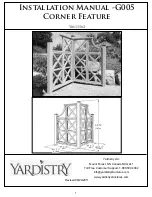
RP0200-2000
NACE International
1
_______________________________________________________________________
Section 1: General
1.1 Steel casings are used to install and maintain
pipeline crossings such as those at road and railroad
rights of way. This standard details acceptable practices
for the design, fabrication, installation, and maintenance
of steel-cased pipelines.
1.2 Use of cased crossings should be avoided unless
required by load considerations, unstable soil conditions,
or when their use is dictated by sound engineering
practices.
1.3 This standard does not imply that utilization of
casings is mandatory or necessary.
1.4 This standard does not imply that cased crossings,
whether electrically isolated or electrically shorted,
contribute to corrosion of a carrier pipe within a cased
crossing. However, cased crossings may adversely
affect the integrity of the carrier pipe by shielding CP
current to the pipe or reducing the CP effectiveness on
the pipe in the vicinity of the casing.
1.5 The practices contained in this standard may or may
not be applicable to casings installed prior to its issuance.
It is presumed that all practices described in this standard
are performed in a safe manner.
_______________________________________________________________________
Section 2: Definitions
Carrier Pipe: The pipe or piping that goes through the
casing or sleeve.
Casing: A metallic pipe (normally steel) installed to
contain a pipe or piping.
Dogleg or Doglegged: A term used to describe an offset
vent pipe. The vent is offset using several fittings and the
shape is similar to a “dog’s leg.”
Electrolytic Contact: Ionic contact between two metallic
structures via an electrolyte.
Holiday Testing: Electrical testing of a coating to locate
imperfections (holidays).
Isolator or Spacer: A dielectric device specifically
designed to electrically isolate a carrier pipe from a
casing and provide support for the carrier pipe.
Metallic Short: Direct or indirect metallic contact
between two metallic structures.
Split Sleeve: A method of in situ casing installation by
welding two halves of the casing (split sleeve) together
around the carrier pipe.
_______________________________________________________________________
Section 3: Design
3.1 Carrier Design
3.1.1 Consideration should be given to adding
supplementary carrier pipe wall thickness, pipe
depth, or concrete coating in lieu of casing.
3.1.2 The carrier pipe shall be effectively coated,
with consideration being given to the application of
supplementary coating. See NACE Standard
RP0169
1
for details.
3.1.3 The carrier pipe shall be properly supported
inside and outside the casing to prevent metallic
contact between the casing and the carrier pipe. See
NACE Standard RP0286
2
for details.
3.2 Casing Design
3.2.1 The casing should be kept as short in length as
possible. This may lessen the chance of shorting.
3.2.2 For pipelines 20 cm (8.0 in.) in diameter and
larger, the diameter of the casing should be a
minimum of 10 cm (4.0 in.) larger than that of the
carrier pipe. For pipelines smaller than 20 cm (8.0
in.) in diameter, the diameter of the casing is
normally a minimum of 5 cm (2 in.) larger than that
of the carrier pipe.
3.2.3 Uncoated casing pipe is normally used. The
use of coated or nonmetallic casing pipe is not
recommended, due to potential shielding problems.
3.2.4 Vent pipes should be installed on both ends of
a casing.
Содержание CP 1
Страница 1: ...CP 1 Cathodic Protection Tester Course Manual February 2005 NACE International 2000 ...
Страница 265: ......
Страница 266: ......
Страница 267: ......
Страница 268: ......
Страница 301: ...RP0169 2002 32 NACE International ISBN 1 57590 035 1 ...
Страница 535: ...TM0101 2001 24 NACE International ISBN 1 57590 137 4 ...
















































